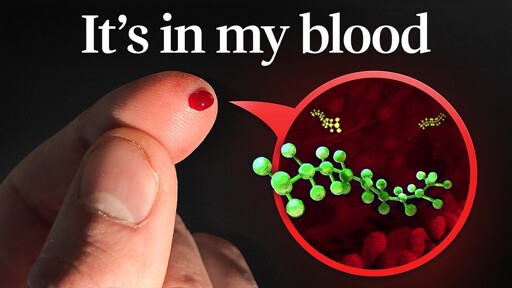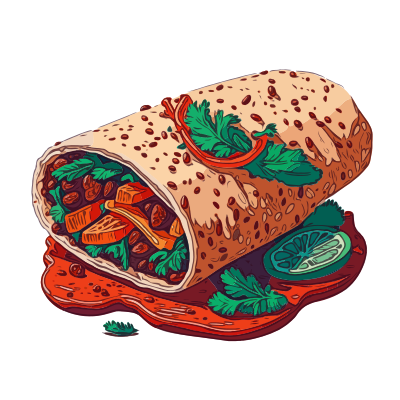It seems I shouldn’t have posted this without context
TL;DW
-
yes the video is (at least partially) about Teflon, hence the cynical title
-
no, Teflon (or generally big Fluoropolymers) are not the problem. Ingesting them does nothing to you, because as long, chemically inert polymers they just pass through you from one end to the other
-
The problem are perfluoroalkyl acids: C8 (PFOA) and later substitutes such as C6/GenX, PFOS, PFHA, PFHxS which are chemicals used to start the Teflon polymerization. They are short-chained carbon-fluorine molecules that coincidentally mimic the structure of fatty acids, thus can accumulate in our bodies without a way for our bodies to break them down.
-
These chemicals leach into the environment from factories and accumulate in everything, to the point that the whole water cycle has been contaminated (yes that shit comes down everywhere with the rain)
-
There is conclusive proof that PFOA exposure is linked to a number of organ damage and cancers, particularly testicular cancer and kidney cancer, with likely links to lung and pancreatic cancer not reflected in the study due to survivor bias (they died before the study was concluded)
They can make Teflon without the forever chemicals. They choose to make it the way they do because it is cheap and easy to scale. Rather than develop better solutions that don’t poison us they choose easy money and are rewarded for it.
We did not do anything. A very small group of people indeed knowingly and willingly poisoned the earth for a bunch of monies.
You’d think they’d be jailed for that, but here we are
This means that now that everyone knows what is required to produce non-stick pans, they will vanish from stores because 99% of humans are well meaning and will not buy destructive products.
Just kidding. My parents (>70yo) told me as achild not to use teflon pans, because they are ‘unhealthy’. We all knew. We just don’t care.
Not “we”. You. Many of us actively campaign against it.
Given the ratio of people who actively campaign against it to people who don’t care, I think it’s pretty safe to say “we don’t care”.
Thx for being in the 1%
I’m more inclined to think that they weren’t willing, but rather that they just didn’t work on the implications. Occam’s razor. Don’t assume evil when stupidity, or laziness, or simple plain cost cutring can explain things.
Teflon found out and yet did nothing. That is willingly.
May have started innocently but there was a point they knew and didn’t care. That is the point where execs should be getting harsh sentences from
and they keep making the shit.
fuck
“We poisoned the planet”
Fuck off! Unscrupulous greed industrialists poisoned the planet knowingly and tried to hide or minimize the fact from the public.
 To be clear: This image is directed at the greedy industrialists.
To be clear: This image is directed at the greedy industrialists.I’m curious where this money actually went. Like which specific people have it right now.
These persons paid a lot to have laws that exempt them from any responsibility.
Sure, of course they’re legally immune. Just curious who they are anyways.
For anyone who can’t be bothered to watch the entire 1 hour episode: It’s not really about frying pans.
The PFAs are everywhere by now. Butter on a pan will do jack shit to save you. It’s really fucked up. You should watch the video.
Yup your most likely sources are stuff like:
- your water supply
- any coated paper materials coming into contact with (hot) food and beverages, eg. Burger wrappers, coated paper coffee cups, microwave popcorn, pizza boxes, etc.
We didn’t poison the whole planet so our eggs wont stick. A small number of people poisoned the planet to get rich
This is the truth!
Firefighting foam used at airports. Every airport, every military base with an airstrip practices routinely with PFAS. They are still doing it.
It is everywhere. Water, soil, rain and you.
I lost a coworker to brain cancer this year that was caused by his exposure to PFAs when he was a firefighter. This shit is fucked.
I happen to live near one. The city had to shut down a well until they could install a filter.
I also have an undersink RO system, but people shouldn’t have to do that.
Which is wild because if you knew how to properly use oil/butter and a cast iron pan… they won’t stick to your pan.
We literally created a world of idiots that don’t know how to do anything.
you are so much smarter than everyone else
Look it’s not my fault people didn’t get an opportunity to learn these skills because they were instead sold cheap, poisonous bullshit. Why would anyone learn if they didn’t have to because there was an easier, cheaper way? It’s not really the fault of individuals who don’t know any better when society isn’t going out it’s way to teach them such skills. Hell, I didn’t learn this until I was in my early thirties, because my parents had used teflon cookware all while I was growing up.
But, please, read it more as me thinking I’m better than everyone else rather than someone who got lucky enough to learn these skills eventually who is disappointed that we were sold poison as an ‘easy’ solution.
Did you read the article? Have you tested your ground & drinking water? If you do drink water then you are at risk. Pans are not the problem, firefighting foams & industrial leaks are.
I only drink Brawndo, so I’m good.
While I agree and have switched to cast iron and stainless steel, it’s not enough. No pfas were used in the manufacturing of my cookware, plus I expect to save money by never having to replace it. However the documentary starts showing how ubiquitous the chemicals are and for how many uses. While we all absolutely need better cookware choices, it’s only a drop in the bucket of so many consumer and industrial products.
Our part includes increased awareness and better choices for many things we come into contact with every day. However it’s critical to better regulate, to hold companies accountable for the damage they’ve done, bring them to justice for impact on public health and coverups, etc …. And that’s not just unlikely but really impossible
Literally a minute of googling. Takes more to make up arguments why youd still use a pan that kills you and has built in planned obsolesce.
hello friend, the pan doesnt kill you. there is no PFOA in the pan you buy and is used to cook the food you buy in a restaurant, which you’ve done hundreds and hundreds of times. its the production of the material on the pan that produces the anti-life compounds.
we don’t get cancer from using nonstick pans, we get cancer from the PFOA in the groundwater that was made during the production process.
it takes literally a minute of googling, but thank you for the condescending message, couldn’t have lived without it
Ingesting teflon particles is bad for you and all the studies assume you are not scraping your teflon pan when in reality the teflon coating DOES flake off over use and following the procedures manufacturers tell you to, thus you are ingesting teflon flakes wether you like it or not.
Cast iron is generally safe but not entirely without risk. Old pans are sometimes made with lead and some newer cheap pans from sketchy sources are made with cadmium and/or lead
Generally if you get like a lodge or whatever you’re fine though. Biggest risk there is that it leeches iron into your food, which is usually beneficial unless you have some uncommon health concerns
A stainless steel pan are also generally safe but have similar issues: low quality pans and excessively scratched pans can leech nickel and chromium. 304 and 316 stainless ($$$) are more resilient against this issue. Stainless takes a bit more technique than cast iron for stuff like eggs and fish but it’s not that tricky (preheat pan, add fat/oil when hot, basically). It is also far more responsive to changing temperature (rather than retaining it) and much lighter so it’s easier to use for sautéing and such. Cast iron is superior when heat retention is needed: stews, soups, curries, roasts, etc
Ceramic coated cookware is a mess. Some did use PFAS/PFOA and still does, some ceramics have lead and cadmium, and some coatings just suck. I got one pan to experiment with that was lead/cadmium/pfoa/pfas free but the nonstick properties dulled after 2-3 months of daily use. It was not scratched or chipped; I took care to not use metal implements or wash it with abrasives. I did use high heat at times though which potentially degraded it. It was like $50 too. Researching online after I see there are “good” ones for $80, fuck spending that on a single pan.
I’ll stick with cast iron and stainless steel. Can use metal utensils, covers basically every scenario, and cheaper. To be clear, “well sourced” doesn’t mean expensive. A 10” lodge cast iron skillet is $20 online. A tramontina 12” 304 stainless frying pan is $35.
Of course if you ever eat at restaurants none of this matters as they’re generally using the cheapest aluminum and steel pans they can get that are beat to utter shit
Can’t we just have AskCulinary back? Please? Kenji…?
I’m so happy that my parents taught me to always use cast iron pans, or at least nonstick with a ceramic layer instead of PFAS
Just to be fair though: ingesting Teflon residue from the pan isn’t the problem, it’s the chemicals needed in the production process to get the Teflon onto the pan, leaching out from the factories into the environment.
I recently switched to cast iron, and I have no fucking idea why I wasted so much time and money on nonstick over the last many years. They are better than nonstick, easier to maintain, and make food taste better as well.
It’s not the idiots fault for being uneducated and being lied to
Funny how some commenters immediately assume that you are excluding yourself from that.
Because what you say goes for so many things, it affects us all invariably. And it reaches very far into time. I mean who still knows how to make their own tools from sticks and stones.
But OP said that this is not what this video is about!
Teflon residue from the pan isn’t the problem, it’s the chemicals needed in the production process to get the Teflon onto the pan, leaching out from the factories into the environment.
For more information about this subject I recommend watching this documentary by independent journalism platform Zembla. That talks in detail about the company DuPont (Chemours) and PFOA. https://m.youtube.com/watch?v=y3kzHc-eV88&pp=ygULWmVtYmxhIHBmb2E%3D
Got myself a set of ceramic coated pans just a few days ago. Am very happy with them. No PFAS at all and much better anti stick than my old teflon pan.
Enameled cast iron is like magic.
Worst case I let it soak for a bit and it comes out clean with just a brush in a minute.The trick is to use wooden spoons to prevent scratching. Egg sticks to the scratches and forces you to make more scratches as you attempt to scrape it off.
The trick is to use any cast iron, carbon steel, stainless and heat the pan then add oil before cooking. zero stick when done after heating
Doesn’t work though if I want to fry something with little or even without oil, which I do on occasion.
You need to thruoughoutly preheat it and roll rhe oil around so it gets into every pore of the pan. You can wipe off excess.
In stews and sauces, excess far can be removed if you don’t emulsify it.
Yeah unfortunately. I wish we can have pans with built-in temperature sensors
Throw water on pan and make sure the beads roll around even after touching the sides.
Ah yes red hot
No, preheated as in everything has reached operating temperature. You know, how we have cooked for 99.999% of mankinds history.
I have a 12 inch stainless steel pan, i preheat it and then add oil but some amount of sticking is inevitable, especially around the edges where ever the food isn’t touching the surface of the pan, the oil burns and polymerises on the pan and it’s a pain to remove, even with barkeepers friend, that’s why I got a 10 inch ceramic hard anodized aluminum pan for cooking eggs and small quantities of foods. I just use the big pan when cooking in bulk now.
I generally use either wood or plastic when cooking with an anti stick pan (although, supposedly ceramic coating can take more of a beating than teflon).
This puts me off it. I like to be able to use metal tools on my pans
I known, me too. But wood is basically uncookable biodegradable plastic that doesn’t give you cancer. So you use it, wash it and re-use it. It gets soaked in food and oils and stuff probably grows in its pores. But at the end of the day you don’t eat the spoon and I haven’t heard of anyone getting sick from a wooden spoon infection. but I’ve heard of millions getting cancer from “somewhere”… Pfoas.
Oh yeah wood cooking stuff is ok, my spoons are wood as I normally use a spoon with a stainless steel saucepan, then it’s a metal spatula on cast iron and I also use it over a fire pit so wood is something I would want to avoid there.
Just learn to use a stainless. The entire trick is literally only preheating.
I might, in the future, get myself a good (set of) steel pans. But for the time being, I have a pretty new set of brand name ceramic coated pans, that I got a very good deal on and that have much better anti stick characteristics than what I’ve seen steel being capable of doing and good steel pans are out of my budget rn.
should i tell you?
Ceramic-coated cookware looks nice and seems like a safe option at first. After all, 100% ceramic is completely safe for cooking purposes. However, a coating of ceramic is usually hiding bad materials.
The soft ceramic coating isn’t the most durable and starts chipping after several months of everyday use. When that happens, lead and cadmium that is sometimes found in the coating will end up in your food and later in your body. Lead poisoning is one of the most dangerous types of metal poisoning and can result in abdominal pain, headaches, infertility, and other health complications (and in severe cases, coma and death). Even when the coating is lead-free, chipped cookware can still present dangers — it’s usually neurotoxic aluminum that’s under the ceramic coating.
Thanks but I specifically bought a set that was lead and cadmium free. Besides that, I don’t use those pans daily, so they’ll still last for a while. Maybe I’ll get steel after, but as of now, I like the characteristics of a good anti-stick coating a lot more than steel.
Also, as soon as they chip, they will be replaced anyways. Why would I cook with a broken pan? You wouldn’t use a steel pan with a hole in it either.
The „the aluminium underneath is unhealthy“ is just as terrible an argument as „the steel pan hurts more when you drop it on your foot“, imo.
Yay, my generations lead poisoning. Fuck capitalism
Use stainless steel and cast iron and nothing else
Carbon steel, glass, clay, ceramic, aluminum, and enameled cast iron are all great too!
Also stainless steel has the potential to leach chromium into foods. Research into this is still preliminary.
If you watch the video, it says there is no reason to switch, as teflon is not poisonous. The catalyst chemicals in manufacturing when released into rivers and other places is the biggest source. Then some shoddy packaging of fast foods.
PFASes are not only used for your pan.
Teflon flakes are poisunous. And your teflon pan becomes useless in a few years, no matter what you do Thanks to teflon flaking off.
Put two and two together. And then add: They need to manufacture a new pan for you.
Teflon is just as poisonous as any plastic above breakdown temperature (260C). I.e.: not really.
There is no eternal item in the human mortal coil.
They could start throwing out steel slag into rivers from the factories, you know. Which is the analogue.
mostly from Aqueous Film Forming Foam
We poisoned the planet for us
To be fair only like 0.1% (yes I made this number up) of all Fluoropolymers end up in frying pans.
Most of it is used in industry, building, medicine…
The original thumbnail had a fork scraping a nomstick pan if anyone is curious
Recently replaced our teflon skillet with a ceramic one, Paris Hilton branded 😂
Ffs watch the video or read the post; Teflon is inert and completely safe, the issue is that to boost the speed of production they used PFAS which are very much dangerous at extremely low quantities, and yet it’s everywhere including rainwater
Edit: the post didnt have a description when you wrote your comment, still please do watch the video
Sure, but if you’re gonna replace a pan anyway, it’d still make sense to buy something else than Teflon because they’re usually manufactured irresponsibly.
It’s good to remind people that if they have a durable good that works fine, but its original manufacture was problematic, then it’s generally better to keep it as long as it’s doing its job. Even if the replacement is less problematic, it’s impossible to make anything without some kind of impact. Keeping durable goods going is better.
Important for this thread is that cast iron, at least right now, is usually made in coal fired furnaces. It’s an incredibly dirty industry. Now, if I need a pan I will tend to prefer cast iron and then use it forever. But don’t throw stuff away that’s perfectly functional.
Yea for sure.
I was mostly thinking about if you already need a replacement.
deleted by creator
u dumb phuk
I’ve not watched the video, but the wording/tone/language of the title stinks of sensationalism and pseudo-science.
If I were to click it, which I won’t, I imagine it’d be clickbait and/or nothing to do with eggs or pans.
EDIT: Based on feedback. I did click. The actual video title is “How one company secretly poisoned the planet” and despite sounding a bit clickbaity, it’s actually on-topic.
I guess my BS detector has been on overdrive recently.
EDIT 2: I watched the whole video and now I feel sad.
You really shouldn’t comment on the content of a video that you purposely have not watched. It comes across as smug and ignorant. Veritasium videos are well researched, and he does his best to not sensationalize. To suggest that he would promote pseudo-science is absolutely laughable.
Do better.
Well, sorry. The problem is, experience with the Internet has taught me to be wary of clicking things like “we poisoned the whole planet”.
This time it was a false positive. Added clarification to my comment.
I’ve updated the post with a short TL;DW section to address your concerns
Thanks. Also added an edit to the end of my comment clarifying that it’s legit.
It’s a veritasium video, titled how one company poisoned the world.
Still click bait but it’s youtube and they have the mighty algorithm to answer too.
Good video well produced and worth the watch
I mean, it’s clickbaty, sure. But also, it’s not wrong
I don’t know what the video is about but here is my opinion on what it’s about
Ffs, are you trolling?
I’ve not clicked and I know it’s almost certainly talking about Teflon
So very much to do with pans, and likely anything cooked in those pans (e.g. eggs)
Edit: okay it’s PFAS in general, Teflon is just a common type people are familiar with
Teflon is not a type of PFAS and is actually safe
Sorry yes, you’re correct, it’s a PTFE. Which is touted as a safe alternative until you find out burning it (about 250 degrees) produces PFAS.
Now if someone perfectly uses the pan and never leaves it on high heat without anything in it, they’re probably gonna be fine. But I’ve lived in the same house as an idiot who has done exactly that, so I’m inclined to think that it’s not an entirely uncommon thing.
Then you’ve also got the post-use phase of the pan’s life where it could easily end up in a waste incinerator, and we already know we have a problem with PFAS hanging around in the environment.
“This one trick pans don’t want you to know”
I haven’t actually yet seen any conclusive proof that PFAS are poisonous to ingest, however
Sure, it’s present everywhere, and I wouldn’t be shocked if we found out it’s bad for us.
But it has to actually be a poison to call it poison.
Pollutant? For sure. Poison? No proof of that yet. Just very annoying but the very principle that makes it hard to scrub out of water (very non reactive and tiny) is also what makes it seem to, so far, show no negative side effects on stuff.
It’s there but kinda just, doing nothing as far as we can see… so far
We need more funding into studies on it.
PFAS are endocrine disruptors. It’s incorrect to say that they do nothing to us. https://pmc.ncbi.nlm.nih.gov/articles/PMC7926449/
“To poison” just means to make people ill by ingesting it. PFOAs are quite well studied and are known carcinogens, and definitely toxic according to multiple studies, this is trivial to find on Wikipedia, etc so… I dunno - seems like a contrarian take?
PFOA studies linking exposure to a number of health conditions, including thyroid disorders, chronic kidney disease, liver disease, testicular cancer, infertility and low birth weight. The list goes on, those are just some.
- https://pubmed.ncbi.nlm.nih.gov/33780327/
- https://pubmed.ncbi.nlm.nih.gov/32944748/
- https://pubmed.ncbi.nlm.nih.gov/32950793/
- https://pubmed.ncbi.nlm.nih.gov/33916482/
- https://pubmed.ncbi.nlm.nih.gov/25567616/
https://en.m.wikipedia.org/wiki/Perfluorooctanoic_acid#Toxicology
it states that the indirect genotoxic (and thus carcinogenic) potential of PFOA cannot be dismissed
Its important to understand that “cannot be dismissed” is not the same as “we think it does do this”
It’s a double negative, its “we dont not think it causes it”, but waaaaay more study is needed.
Serum Concentrations of Per- and Polyfluoroalkyl Substances and Risk of Renal Cell CarcinomaActually is a new one for me, I havent seen this one, and it does look much more compelling than the other smaller studies, this one is more concerning than the others.The Panel determined in 2012 there was a ‘probable link’ (i.e., more probable than not based on the weight of the available scientific evidence)
Fourth link is a lot of nothing, why did you bother linking it? It just discusses other studies but doesnt add anything new of substance.
Fifth link is pretty sketchy, theres many other variables that also associate, and they didnt even find a link between specifically PFOS anyways
while no significant association was observed for PFOS (OR = 1.14; 95% CI 0.98-1.34; P = 0.09)
Its important to note that every single one of these studies is empirical post exposure which means many other associated variables can also contribute.
People with low PFAS vs high PFAS exposure almost undoubtedly are also exposed to many other things… like pollution in general
It’s borderline impossible to actually separate out PFAS levels from these other entangled variables, people who are heavily exposed to 1 type of pollution will also be exposed to many others, and theres a heavy association between living situation and PFAS exposure.
That is why its so damn hard to get any conclusive proof on this, the only way to truly figure it out would be to purposefully administer PFAS to people intentionally in a controlled environment, to try and separate out variables.
The relationships that do show up are all very tenuous, and could easily be also explained by the dozens of other variables, so thats why you keep seeing the wording of “may contribute” or “requires further study” or “associated with”
Your comment cherry picks the weakest language of the Wikipedia article and studies and ignores the rest. You’ll struggle to find any reremovedble study anywhere that says “our study proves that X does Y” like you’re asking, because thats not how studies language is conveyed and would be incorrect language to use in a medical study. When 20 studies all say “we have shown a strong correlation between cigarette consumption and cancer of the throat, mouth, and lungs” then you will hear scientists say “the link between cancer and cigarettes is known, and well studied” and news articles will say “cigarettes cause cancer”.
Your suggestion that the only way we’d know for sure is human trials of intentional PFOA exposure is… I’m gonna be generous and say… naieve. Scientists are perfectly fine with using lab, mouse, and emprical cross-sectional studies - that’s all valid scientific evidence. They don’t actually need to take the final Dr Mengele step of subjecting people directly to suspected toxins before they can draw highly accurate conclusions, especially for something like PFOA that has large sections of the population with high dosages that they can compare against those with low dosages already.
It’s borderline impossible to actually separate out PFAS levels from these other entangled variables, people who are heavily exposed to 1 type of pollution will also be exposed to many others, and theres a heavy association between living situation and PFAS exposure.
Not true. Just one example, we have many population groups that live in areas where groundwater is used for drinking that also live near a firefighting training base/station that has released huge amounts of PFOAs into the aquifers. These populations are otherwise quite normally distributed for age/weight/health/occupation and exposure to other chemicals and perfect for study of PFOAs and have been shown in studies to have much higher levels in their blood serum.
It’s fine though - if you wanna sprikle PFOA on your cereal or something until 100 more studies are done, I can’t stop you. But just know that your tendency to cherry pick data and your unconventional assessment methods of studies is giving you a very poorly informed choice.
Just one example, we have many population groups that live in areas where groundwater is used for drinking that also live near a firefighting training base/station that has released huge amounts of PFOAs into the aquifers
Crazy as it sounds but living next to a firefighting training station still biases you towards certain living conditions
Scientists are perfectly fine with using lab, mouse, and emprical cross-sectional studies - that’s all valid scientific evidence.
Yeah obviously, but that’s still evidence, not proof, I used the word proce there intentionally.
I’m not suggesting they actually do it, I’m calling out people that take a bunch of very good evidence and then treat it like it’s proof. That’s all
And I’ve been using the words proof/prove this whole time.
There’s lots of evidence, but there’s not enough yet to do more than draw an interesting corollation.
But there’s definitely no proof and click bait videos that word it as such are trash
Thats what I am addressing, numties taking this evidence and running off with it to spread disinformation framing it as proof via their choice of words.
Jesus. Fucking. Christ. People need to learn to read.
I’m not sitting here saying PFAS dont cause issues
I’m sitting here calling out clickbait youtubers who frame evidence as proof via poor wording to incite people
God fucking damnit I hate how much people on the internet are so focused on bring right they won’t even read what you write properly just so they can find things to pick a fight over. Fuck off lol
God fucking damnit I hate how much people on the internet are so focused on bring right they won’t even read what you write properly just so they can find things to pick a fight over. Fuck off lol
You mean like someone going uhmm acktually it’s not technically a poison, I wish people wouldn’t complain about a substance poisoning people when there’s no evidence it’s poison attempting to make a fairly pointless pedandic statement, while also being confidently incorrect?
There is (according to the video) concrete evidence for both acute toxicity as well as causal carcinogenic effects when it comes to PFOA.
The distinction here is between long-chained Fluoropolymers like Teflon, which are completely benign as far as evidence suggests; and fluoroalkyl acids (like PFOA), that are short-chained, can enter the bloodstream, and mimic the structure of fatty acids thus being able to bond to stuff in our body.
No, there’s a very minor causational link that has been classified as “needs further study”
Its extremely far away from “concrete evidence”, that’s what Im talking about when saying this video was hypebole.
Many places are classifying it as potentially hazardous to be safe, because:
- Theres safer alternatives anyways
- Better safe than sorry, its not a missions critical option
I haven’t actually yet seen any conclusive proof that PFAS are poisonous to ingest
That happens when you bury your head in the sand and refuse to learn anything.
… No? I consider myself pretty well read.
If you have any conclusive peer reviewed papers that prove PFAS are poisonous if ingested at such microscopic scales, please by all means… link them
I have been keeping an eye on the progression of study on PFAS for nearly 6 years now since they started finding it all over the world. Im not gonna claim it isnt poisonous, but I certainly am gonna say despite all the studying, no actual issues have been found with them yet that have been repeatable in peer reviewed studies.
Everything seems to still be quite a bit inconclusive so far. Albeit I also chalk a lot of that up to a pretty heavy amount of muzzling on actually researching the impact of PFAS. If you have anything that proves otherwise though, by all means share it with the rest of the class.
Now, if you wanna talk about inhaling vapors from burnt PFAS, now we are talking about potential poisons that can really fuck you up.
But the quantity of PFAS in things like drinking water seems to be so incredibly low and some studies have shown that boiling water actually helps remove many different types of microplastics, including PFAS, due to interesting effects of sodium deposits in the water forming that bind to them sorta Katamari Damacy style.
But other than that, no, I havent seen anything else, just a loooot of “inconclusive, needs further study” stuff published time and time again.
It took me 5 minutes to find this.
You clearly didn’t read it, it’s just a giant metastudy gathering up tonnes of research but it’s basically just a shotgun paper covering all the “maybes” that have been highlighted
It cites dozens and dozens of papers, most of which highlight “maybe possibly potentially PFAS levels corrolate with (insert health effect here)”
However it also glosses over tonnes of other studies that havent found links to be statistically significant.
I want you to read this XKCD comic and try and understand how it relates to the discussion
You sound like the people that will argue that climate change is made up by China or some silly bullshit like that. Rejecting all data with claims that it’s fake.
People like you aren’t worth the time.
No.
There’s a huge difference between rejecting data and just pointing out that nearly every single study is too small and underfunded and nearly every one of them is preliminary.
There’s a reason all these papers are careful to say stuff like “more research is needed”
The goal of science is to try and prove the negative
You never actually can sufficiently prove your goal, but you can disprove other possibilities to narrow alternative reasons down until you get as close as possible to your outcome being the only remaining reason left.
This has not been achieved with PFAS studies yet simply due to a lack of time and quantity. Most of these studies are either too small, or too specific to do anything more than conclude “well, this definitely is interesting and should be investigated more”
Because proving it actually for sure does something is incredibly challenging, because there’s thousands of other variables at play, and many of the studied symptoms don’t display massive magnitudes in change.
Not enough to be very certain that they aren’t being caused by some other factor that pairs up with PFAS exposure.
For example, PFAS exposure also will correlate with other possible exposures to pollutants simultaneously for the same reason you got exposed to PFAS.
Air pollution levels also correlate, once again, same reason.
It’s devilishly challenging when the people with above average PFAS exposure also are getting exposed to other pollutants to then narrow down to just PFAS being the cause. It could be the wrong chemical causing issues… or ot could be 100% the cause.
It’s not like Asbestos where we could find villages with clean drinking water and air quality with zero other concerns that had huge issues due to being downwind of a mine.
If they managed to find a large group of people downstream of a plant that only dumped PFAS in the water and not other pollutants too, you’d be in business.
But that isn’t a thing, they dump all manner of shit in there with the PFAS, so can you see how that fucks up the numbers?
Even watching a video is too hard for you, poor baby
No, I watched it, and the end result is a lot of hyperbole.
















